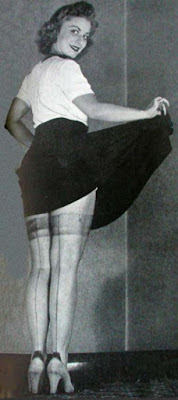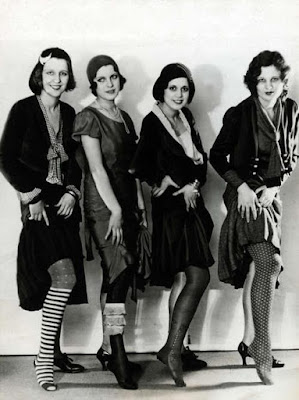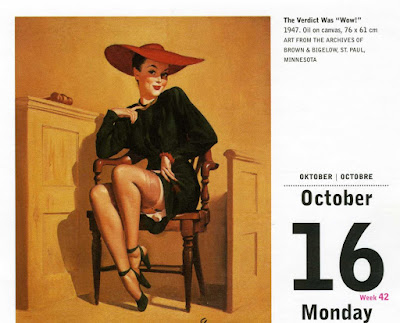August 9, 2021
On Saturday, the NFL Hall of Fame received its 2020 inductees (delayed because of the pandemic) and this year’s class. Two of 2020’s HOFers were Bill Cowher, who coached the Pittsburgh Steelers for 15 seasons, and Troy Polamalu, first round draft pick of the Steelers in 2003, and all-star safety for 12 seasons. Pittsburgh sports writer Dejan Kovacevic said, “If you’ve ever been blessed to have any connection in your life with the city of Pittsburgh, you have no chance – none – to get through this with a dry eye.” He was talking about Troy's speech. If you are a Steelers fan, take the dare.
👉 And now, as promised, the conclusion to the pantyhose story. Hosiery’s first origins can be found in its name, a term deriving from the Old English word “hosen’ which means “covering.” Hose or hosiery were worn as early as the 15th and 16th centuries. At first, hose was worn almost exclusively by European noble men. This was for practical reasons of the era such as better mobility while riding horseback.
 |
| King Charles IX of France wearing padded hosiery in 1566 |
Queen Elizabeth I was the first well known woman to have worn stockings and have it recorded. She received her first pair of knit silk stockings in 1560. The queen adored the softness and comfort of the luxury accessory and decided to wear silk stockings for the rest of her life.
Throughout the 18th and 19th centuries, while hosiery or legwear in some form was worn by women for modesty, warmth, and protection, dresses were kept long and stockings kept short. By the 1920’s, hemlines were on the rise, and so too was the popularity of hosiery to cover exposed legs. The typical stocking of the roaring twenties would come up to just above the knee and be secured by a garter. Suspension belts, which had been invented in 1912, were an additional way to hold up stockings. While hosiery previously was meant to be hidden under dresses and skirts, flappers and women of the decade now flaunted their fishnet and embellished stockings. Hosiery was embraced as a statement of style and freedom.
In 1939, DuPont invented nylon, revolutionizing the world of fashion and hosiery. Not only was nylon a cheaper material, its elasticity also made for a better fit for women of all shapes and sizes. Nylon stockings were all the craze and became an essential for every woman’s wardrobe. By the late 1930’s, political tensions between America and Japan were on the rise. 1937 brought a nationwide boycott of all Japanese products – this included the ever so popular silk stocking. American women were now forced to turn away from silk hosiery and wear nylon instead.
World War II increased demand for nylon. Women were asked to ration and donate their hosiery for the war effort, as the material was used to create tools such as parachutes, airplane chords, and tents. The product was taken off the market completely and desperate women all over sought out creative alternatives. Women began to paint seams on the back of their legs and use “liquid stockings” to create the illusion that they were wearing hosiery.
 |
| A salon applying liquid stockings |
 |
An incredible artistic display of liquid stockings, complete with back seam, “reinforced” top and ankle application |
Applying the cosmetic stocking liquid, lotion, cream or stick evenly so that there were no streaks took practice. Fortunately, help on how to achieve the best results was available from the place of purchase and from articles in newspapers and magazines. And a video demonstrating the successful application.
Advertising in the 1950’s and 60’s romanticized the idea of hosiery and the women who wore it. Stockings were high end fashion accessories, worn by celebrities. Harry Ekman painted pin-up girls wearing stockings that led to glamorization of thigh highs. His portrayals made the everyday woman feel that she could be as glamorous a Broadway star when wearing her hold ups.
Pop icon Twiggy furthered this idea as she popularized mini-skirts and dresses with stockings. Higher hemlines brought increasing popularity to tights and pantyhose as stockings were marginalized. And now you know the rest of the story.
👉 Tomorrow, the first in a series about America’s monuments, beginning with the Tomb of the Unknown Soldier.
👉 “If the Taliban had seized three provincial capitals in northern Afghanistan a year ago, like they did on Sunday, the American response would most likely have been ferocious. Fighter jets and helicopter gunships would have responded in force, beating back the Islamist group or, at the very least, stalling its advance. But these are different times. What aircraft the U.S. military could muster from hundreds of miles away struck a cache of weapons far from Kunduz, Taliqan or Sar-i-Pul, the cities that already had been all but lost to the Taliban.
“The muted American response on Sunday showed in no uncertain terms that America’s 20-year war in Afghanistan is over. The mismanaged and exhausted Afghan forces will have to retake the cities on their own, or leave them to the Taliban for good. The recent string of Taliban military victories has not moved President Biden to reassess his decision to end the U.S. combat mission by the end of the month, senior administration officials said Sunday. But the violence shows just how difficult it will be for Mr. Biden to extract America from the war while insisting that he is not abandoning the country in the middle of a brutal Taliban offensive” [emphasis added].
Go back and read that first sentence – the one that begins “If the Taliban ...” These two paragraphs are copied directly from The New York Times, who throughout his presidency was openly hostile to Donald Trump, and now seems to applaud a different approach – at least towards Afghanistan. How times have changed.
👉 Speaking of changing times, in October 1963 Bob Dylan wrote an anthem of change for the times, and the lyrics still seem to have application over the decades. “The Times They Are a-Changin’” became the archetypal protest song.
👉 As long as we’re playing music, here is a great video featuring Glen Campbell playing “The William Tell Overture.” Watch his left hand as his fingers fly over the neck of the guitar, and at the end, be mind-boggled as he puts the guitar on top of his head and doesn’t miss a note.
And Glen singing “Gentle On My Mind.” This clip features Glen surrounded by country music greats. I don’t know the show, but I identified Chet Atkins, Roy Clark, Willie Nelson, Paul Stookey, and Ralph Emery (it might have been from one of the shows Emery hosted).
And “By the Time I Get to Phoenix.”
One more. “Wichita Lineman” from a live concert in Sioux Falls, 2001 (“The William Tell Overture” is from the same concert).
👉 Some signs for the times before we close:
👉 Today’s close “We All Need a Father,” is from The Great House of God, by Max Lucado.
Recently, my daughter Jenna and I spent several days in the old city of Jerusalem. One afternoon, as we were exiting the Jaffa gate, we found ourselves behind an orthodox Jewish family – a father and his three small girls. One of the daughters, perhaps or five years of age, fell a few steps behind and couldn’t see her father. “Abba!” she called to him. He stopped and looked. Only then did he realize he was separated from his daughter. “Abba!” she called again. He spotted her and immediately extended his hand
He held her hand tightly in his as they descended the ramp. When the signal changed, he led her and her sisters through the intersection. In the middle of the street, he reached down and swung her up into his arms and continued their journey.
Isn’t that what we all need? An abba who will hear when we call? Who will take our hand when we are weak? Who will guide us through the hectic intersections of life? Don’t we all need an abba who will swing us up into his arms and carry us home? We all need a father.
-30-










No comments:
Post a Comment